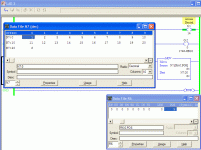wildcatherder
Member
After figuring out that "Indirect addressing" is basically what the rest of the world would call indexed addressing (as in C language array indexing) I tried to use the following as a destination address for a MOV instruction,
N7:[R6:0.POS]
which uses the step number of an SQO instruction to describe which word of the file N7 should be used.
I found that it simply did not work.
However, if I used a MOV command to put the value of R6:0.POS into an integer word location - N7:0, I was then able to use
N7:[N7:0]
as the destination and it worked successfully.
I would be interested in knowing, if there other file types, besides Control, which would exhibit this problem. Or is it simply that there is .xxx description at the end?
The Indirect addressing syntax is shown on page 98 of Publication 1766-RM001A-EN-P Micrologix 1400 Programmable Controllers - Instruction Set Reference Manual.
N7:[R6:0.POS]
which uses the step number of an SQO instruction to describe which word of the file N7 should be used.
I found that it simply did not work.
However, if I used a MOV command to put the value of R6:0.POS into an integer word location - N7:0, I was then able to use
N7:[N7:0]
as the destination and it worked successfully.
I would be interested in knowing, if there other file types, besides Control, which would exhibit this problem. Or is it simply that there is .xxx description at the end?
The Indirect addressing syntax is shown on page 98 of Publication 1766-RM001A-EN-P Micrologix 1400 Programmable Controllers - Instruction Set Reference Manual.





